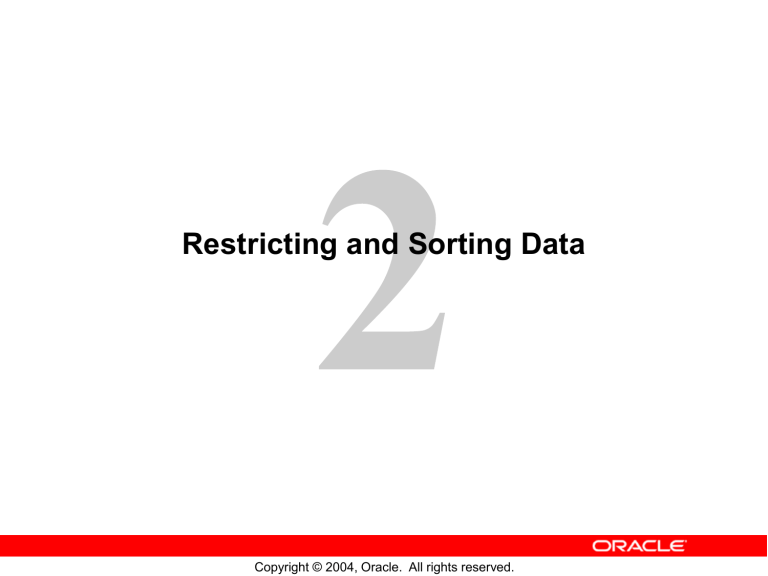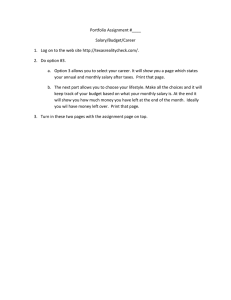
Restricting and Sorting Data
Copyright © 2004, Oracle. All rights reserved.
Objectives
After completing this lesson, you should be able to do
the following:
• Limit the rows that are retrieved by a query
• Sort the rows that are retrieved by a query
• Use ampersand substitution in iSQL*Plus to
restrict and sort output at run time
2-2
Copyright © 2004, Oracle. All rights reserved.
Limiting Rows Using a Selection
EMPLOYEES
…
“retrieve all
employees in
department 90”
2-3
Copyright © 2004, Oracle. All rights reserved.
Limiting the Rows That Are Selected
•
Restrict the rows that are returned by using the
WHERE clause:
SELECT *|{[DISTINCT] column|expression [alias],...}
FROM
table
[WHERE condition(s)];
•
2-4
The WHERE clause follows the FROM clause.
Copyright © 2004, Oracle. All rights reserved.
Using the WHERE Clause
SELECT employee_id, last_name, job_id, department_id
FROM
employees
WHERE department_id = 90 ;
2-5
Copyright © 2004, Oracle. All rights reserved.
Character Strings and Dates
•
•
•
Character strings and date values are enclosed by
single quotation marks.
Character values are case-sensitive, and date
values are format-sensitive.
The default date format is DD-MON-RR.
SELECT last_name, job_id, department_id
FROM
employees
WHERE last_name = 'Whalen' ;
2-6
Copyright © 2004, Oracle. All rights reserved.
Comparison Conditions
Operator
=
Equal to
>
Greater than
>=
2-7
Meaning
Greater than or equal to
<
Less than
<=
Less than or equal to
<>
Not equal to
BETWEEN
...AND...
Between two values
(inclusive)
IN(set)
Match any of a list of values
LIKE
Match a character pattern
IS NULL
Is a null value
Copyright © 2004, Oracle. All rights reserved.
Using Comparison Conditions
SELECT last_name, salary
FROM
employees
WHERE salary <= 3000 ;
2-8
Copyright © 2004, Oracle. All rights reserved.
Using the BETWEEN Condition
Use the BETWEEN condition to display rows based on a
range of values:
SELECT last_name, salary
FROM
employees
WHERE salary BETWEEN 2500 AND 3500 ;
Lower limit
2-9
Upper limit
Copyright © 2004, Oracle. All rights reserved.
Using the IN Condition
Use the IN membership condition to test for values in
a list:
SELECT employee_id, last_name, salary, manager_id
FROM
employees
WHERE manager_id IN (100, 101, 201) ;
2-10
Copyright © 2004, Oracle. All rights reserved.
Using the LIKE Condition
•
•
Use the LIKE condition to perform wildcard
searches of valid search string values.
Search conditions can contain either literal
characters or numbers:
– % denotes zero or many characters.
– _ denotes one character.
SELECT
FROM
WHERE
2-11
first_name
employees
first_name LIKE 'S%' ;
Copyright © 2004, Oracle. All rights reserved.
Using the LIKE Condition
•
You can combine pattern-matching characters:
SELECT last_name
FROM
employees
WHERE last_name LIKE '_o%' ;
•
2-12
You can use the ESCAPE identifier to search for the
actual % and _ symbols.
Copyright © 2004, Oracle. All rights reserved.
Using the NULL Conditions
Test for nulls with the IS NULL operator.
SELECT last_name, manager_id
FROM
employees
WHERE manager_id IS NULL ;
2-13
Copyright © 2004, Oracle. All rights reserved.
Logical Conditions
Operator
2-14
Meaning
AND
Returns TRUE if both component
conditions are true
OR
Returns TRUE if either component
condition is true
NOT
Returns TRUE if the following
condition is false
Copyright © 2004, Oracle. All rights reserved.
Using the AND Operator
AND requires both conditions to be true:
SELECT
FROM
WHERE
AND
2-15
employee_id, last_name, job_id, salary
employees
salary >=10000
job_id LIKE '%MAN%' ;
Copyright © 2004, Oracle. All rights reserved.
Using the OR Operator
OR requires either condition to be true:
SELECT
FROM
WHERE
OR
2-16
employee_id, last_name, job_id, salary
employees
salary >= 10000
job_id LIKE '%MAN%' ;
Copyright © 2004, Oracle. All rights reserved.
Using the NOT Operator
SELECT last_name, job_id
FROM
employees
WHERE job_id
NOT IN ('IT_PROG', 'ST_CLERK', 'SA_REP') ;
2-17
Copyright © 2004, Oracle. All rights reserved.
Rules of Precedence
Operator
Meaning
1
Arithmetic operators
2
Concatenation operator
3
Comparison conditions
4
IS [NOT] NULL, LIKE, [NOT] IN
5
[NOT] BETWEEN
6
Not equal to
7
NOT logical condition
8
AND logical condition
9
OR logical condition
You can use parentheses to override rules of precedence.
2-18
Copyright © 2004, Oracle. All rights reserved.
Rules of Precedence
2-19
SELECT
FROM
WHERE
OR
AND
last_name, job_id, salary
employees
job_id = 'SA_REP'
job_id = 'AD_PRES'
salary > 15000;
1
SELECT
FROM
WHERE
OR
AND
last_name, job_id, salary
employees
(job_id = 'SA_REP'
job_id = 'AD_PRES')
salary > 15000;
2
Copyright © 2004, Oracle. All rights reserved.
Using the ORDER BY Clause
•
Sort retrieved rows with the ORDER BY clause:
– ASC: ascending order, default
– DESC: descending order
•
The ORDER BY clause comes last in the SELECT
statement:
SELECT
last_name, job_id, department_id, hire_date
FROM
employees
ORDER BY hire_date ;
…
2-20
Copyright © 2004, Oracle. All rights reserved.
Sorting
•
Sorting in descending order:
SELECT
last_name, job_id, department_id, hire_date
FROM
employees
1
ORDER BY hire_date DESC ;
•
Sorting by column alias:
SELECT employee_id, last_name, salary*12 annsal
FROM
employees
ORDER BY annsal ;
•
Sorting by multiple columns:
SELECT last_name, department_id, salary
FROM
employees
ORDER BY department_id, salary DESC;
2-21
2
Copyright © 2004, Oracle. All rights reserved.
3
Substitution Variables
... salary = ? …
… department_id = ? …
... last_name = ? ...
I want
to query
different
values.
2-22
Copyright © 2004, Oracle. All rights reserved.
Substitution Variables
•
Use iSQL*Plus substitution variables to:
–
•
Temporarily store values with single-ampersand (&)
and double-ampersand (&&) substitution
Use substitution variables to supplement the
following:
– WHERE conditions
– ORDER BY clauses
– Column expressions
– Table names
– Entire SELECT statements
2-23
Copyright © 2004, Oracle. All rights reserved.
Using the & Substitution Variable
Use a variable prefixed with an ampersand (&) to
prompt the user for a value:
SELECT employee_id, last_name, salary, department_id
FROM
employees
WHERE employee_id = &employee_num ;
2-24
Copyright © 2004, Oracle. All rights reserved.
Using the & Substitution Variable
101
1
2
2-25
Copyright © 2004, Oracle. All rights reserved.
Character and Date Values
with Substitution Variables
Use single quotation marks for date and character
values:
SELECT last_name, department_id, salary*12
FROM
employees
WHERE job_id = '&job_title' ;
2-26
Copyright © 2004, Oracle. All rights reserved.
Specifying Column Names,
Expressions, and Text
SELECT employee_id, last_name, job_id,&column_name
FROM
employees
WHERE &condition
ORDER BY &order_column ;
salary
salary > 15000
last_name
2-27
Copyright © 2004, Oracle. All rights reserved.
Using the && Substitution Variable
Use the double ampersand (&&) if you want to reuse
the variable value without prompting the user each
time:
SELECT
employee_id, last_name, job_id, &&column_name
FROM
employees
ORDER BY &column_name ;
…
2-28
Copyright © 2004, Oracle. All rights reserved.
Using the iSQL*Plus DEFINE Command
•
•
Use the iSQL*Plus DEFINE command to create and
assign a value to a variable.
Use the iSQL*Plus UNDEFINE command to remove
a variable.
DEFINE employee_num = 200
SELECT employee_id, last_name, salary, department_id
FROM
employees
WHERE employee_id = &employee_num ;
UNDEFINE employee_num
2-29
Copyright © 2004, Oracle. All rights reserved.
Using the VERIFY Command
Use the VERIFY command to toggle the display of the
substitution variable, both before and after iSQL*Plus
replaces substitution variables with values:
SET VERIFY ON
SELECT employee_id, last_name, salary, department_id
FROM
employees
WHERE employee_id = &employee_num;
old
new
2-30
3: WHERE
3: WHERE
employee_id = &employee_num
employee_id = 200
Copyright © 2004, Oracle. All rights reserved.
Summary
In this lesson, you should have learned how to:
• Use the WHERE clause to restrict rows of output:
– Use the comparison conditions
– Use the BETWEEN, IN, LIKE, and NULL conditions
– Apply the logical AND, OR, and NOT operators
•
Use the ORDER BY clause to sort rows of output:
SELECT *|{[DISTINCT] column|expression [alias],...}
FROM
table
[WHERE condition(s)]
[ORDER BY {column, expr, alias} [ASC|DESC]] ;
•
2-31
Use ampersand substitution in iSQL*Plus to
restrict and sort output at run time
Copyright © 2004, Oracle. All rights reserved.
Practice 2: Overview
This practice covers the following topics:
• Selecting data and changing the order of
the rows that are displayed
• Restricting rows by using the WHERE clause
• Sorting rows by using the ORDER BY clause
•
2-32
Using substitution variables to add flexibility to
your SQL SELECT statements
Copyright © 2004, Oracle. All rights reserved.




